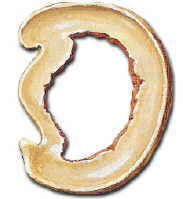Meniscus
The meniscus is the distal cartilage tissue that is found between the weightbearing bones of the knee joint. It acts as a shock absorber. It is usually very tough and rubbery. It does grow weaker with age and meniscal tears can occur with fairly minor injuries in older patients. In younger populations a tear is usually the result of a fairly forceful injury. When the meniscus tears a piece of cartilage can move abnormally in the joint causing catching, buckling and swelling. Swelling usually occurs initially and can sometimes continue occurring with a meniscal tear.
Treatment Options
If a tear is very small and symptoms resolve quickly and there is just occasional discomfort but no instability, a patient can be treated with an exercise and range of motion program. If the symptoms continue then a meniscus can be repaired or partially removed arthroscopically. A large part of a meniscus has no direct blood supply and therefore spontaneous healing on its own is unusual.
To repair a meniscus sutures can be used or new absorbable tact can be used. Using the newer absorbable tacks all the work can be done without additional incisions in the knee. In cases where a meniscus cannot be repaired just the offending torn tissue is removed in order to preserve as much cartilage function as possible.
Arthroscopy is done on an outpatient basis. Usually three small incisions in the knee are used. The patient is begun on immediate weight-bearing and to move the knee as tolerated.
New Techniques
In certain cases where most of the medial or lateral meniscus has been removed meniscus transplantation is now being performed. This is where a meniscus is transplanted from a cadaver after being appropriately sized by new measurements and studies.
Parrot Break Tear
Bucket Handle Tear
Radial Tear
Longitudinal Tear




